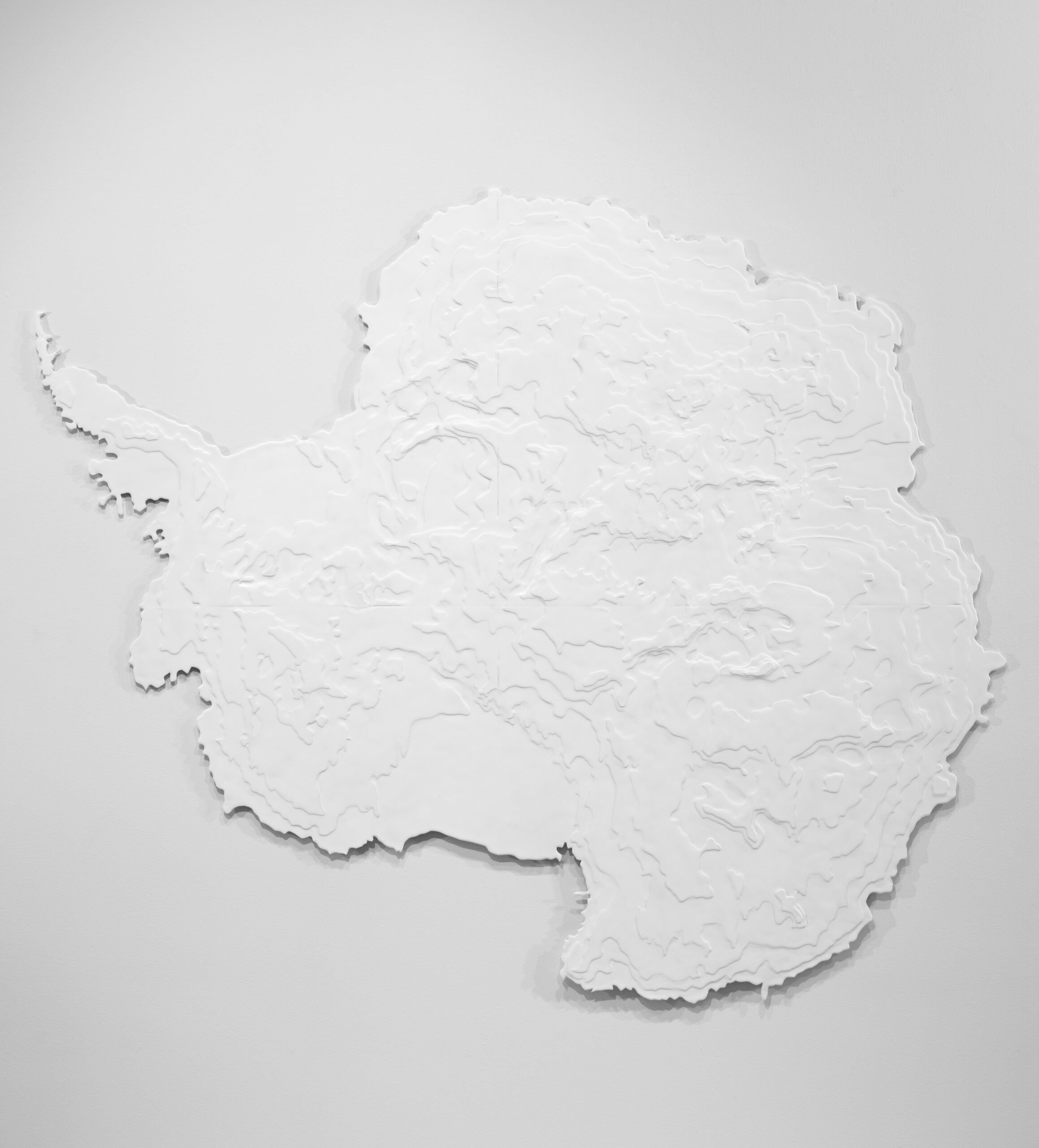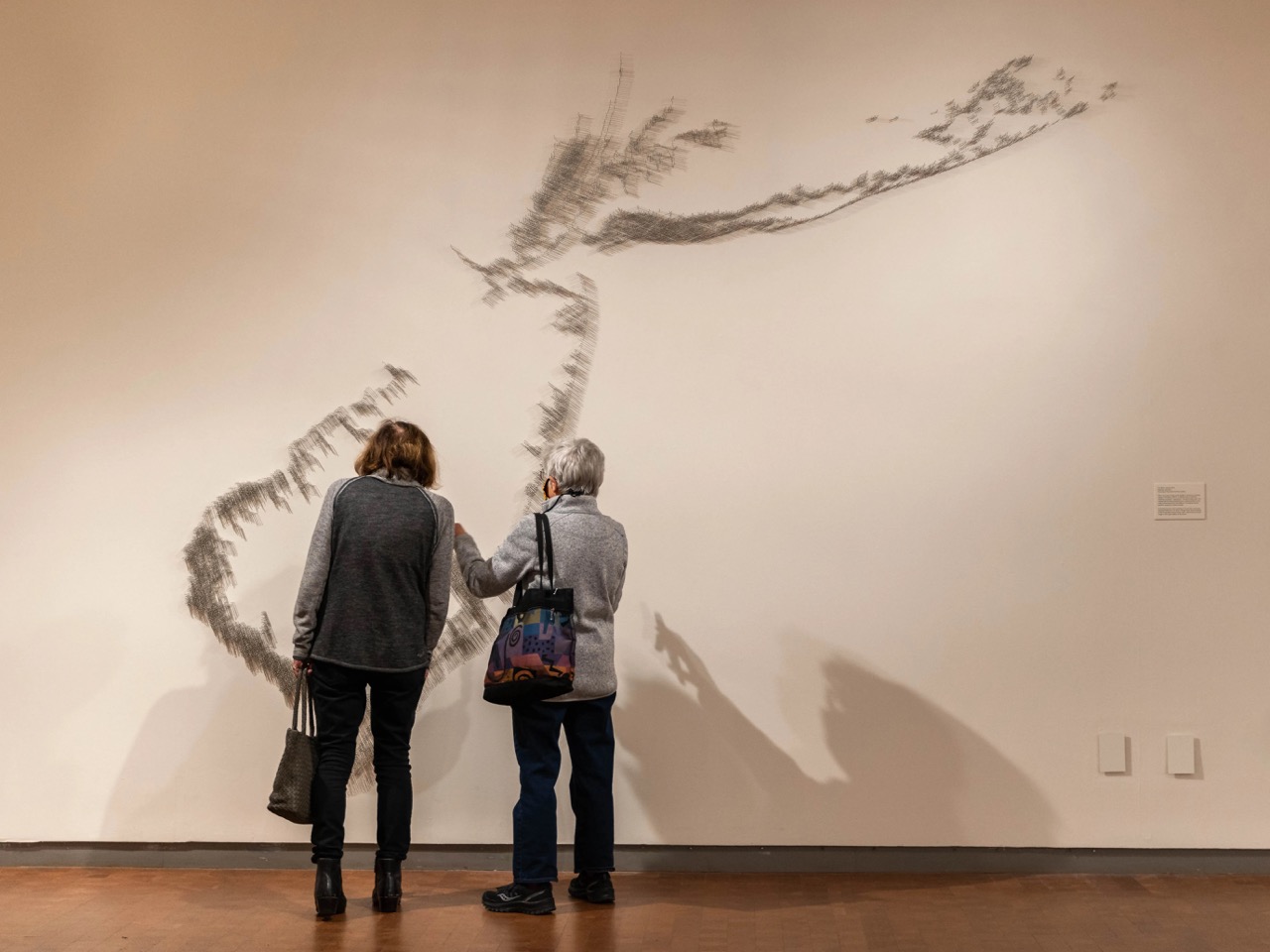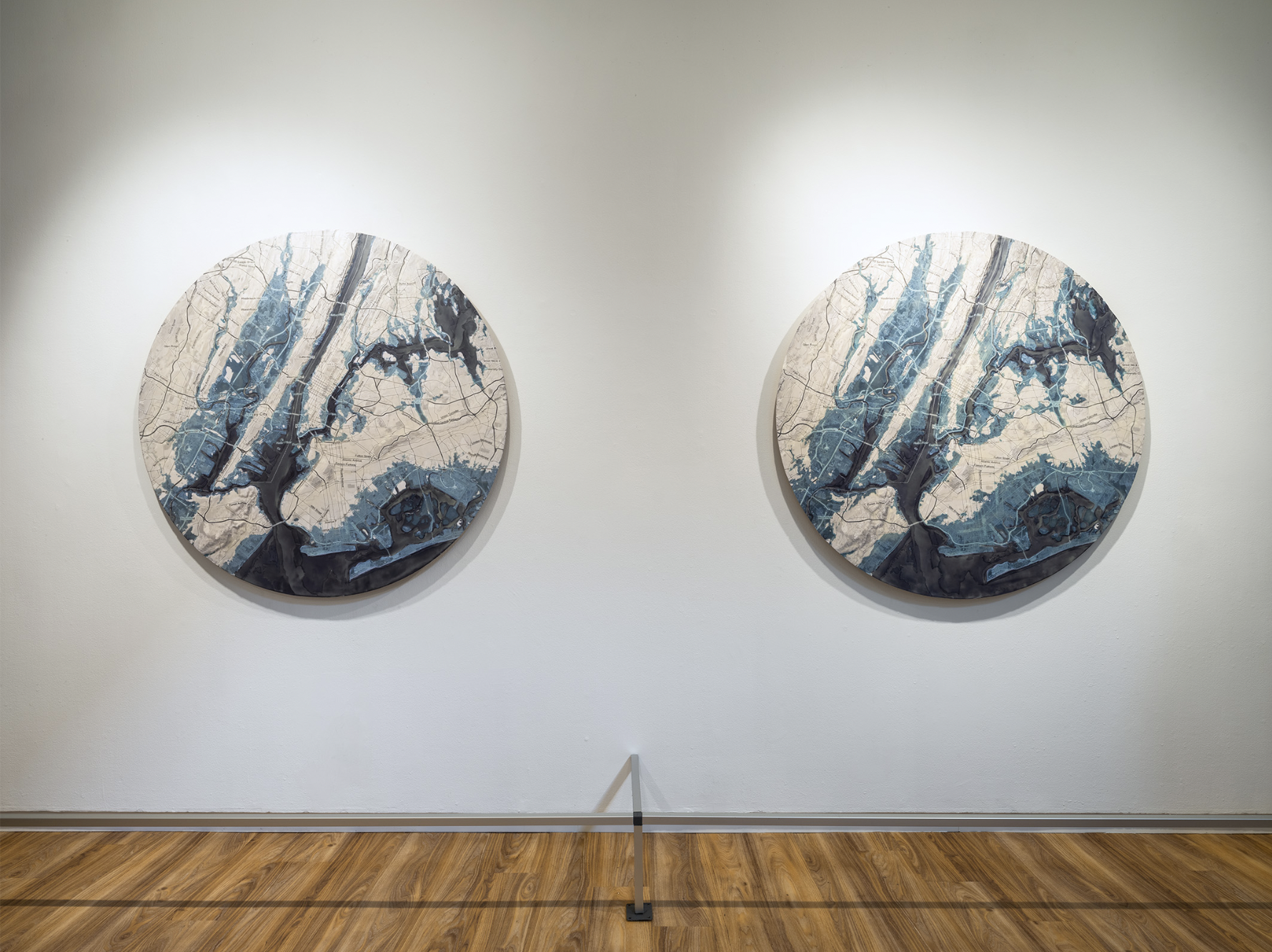
Photograph of Maya Lin (Photograph by Jesse Frohman), an American artist who specializes in design and architecture (from Smith College Museum of Art, 2022). Mappings is one of Lin’s solo exhibitions focused on environmental issues.
- Mappings is an art exhibit displaying over twenty pieces by American artist and architectural designer Maya Lin (image above). Individual artworks took a variety of forms: from paper atlases and plywood models to steel pin wall maps. Mappings was on display at the Smith College Museum of Art (SCMA) in Massachusetts, U.S. from January to August 2022.
- This exhibit raises awareness of human-induced climate change and its effects on the natural environment. Using a variety of artistic mediums, Lin displays complex quantitative data in a more digestible form, bridging the gap between scientists and the general public. Mappings contained four different climate-related sections: water, land, ice, and climate change.
- You can take a virtual tour of the exhibit here.
How is this related to climate?
- Many individual art objects in Mappings objectively portray real-world topographical or physical features. Lin employs earthy neutral colors and natural materials to ground viewers in their environment and emphasize the subtlety of our planet’s features. This was done intentionally to contrast our society’s loud and flashy portrayal of the climate crisis. Through Mappings, Lin aimed to engage her viewers with climate change by making people aware of their surroundings through an unbiased lens.
- Before it Slips Away (image below) is a model of Antarctic ice created in 2017. The title of the artwork points to its message of preserving precious ice in a period of rapid change. Due to anthropogenic climate change and rising global temperatures, ice is melting at unprecedented rates. This is changing habitats around the world, as sea ice and glaciers are lost and coastal areas are pushed back by rising sea levels.
- In 2017, record-low sea ice was detected surrounding the Antarctic continent. Since then, even less sea ice has been reported in the spring of 2022 and 2023, indicating a trend of melting ice.

Photograph of Maya Lin’s Before it Slips Away, a paperboard, encaustic (wax inlay) and aluminum wall piece. This 55 x 65 inch (140 x 167 centimeter) art object models Antarctic ice, as it looked in 2017, from an overhead perspective (from SCMA, 2022).
- Pin River– Sandy (image below) depicts the areas flooded by Hurricane Sandy. This superstorm hit the east coast of the U.S. in October 2012 and caused approximately $70 billion in damage. The U.S. states of New York and New Jersey were the most affected by flooding. In New York City, subways and neighborhoods along the Hudson River flooded, and some areas were hit by tidal surges over 13 feet (4 meters) tall.
- Pin River– Sandy is a ten-foot-long (3 meters) work made of 17,000 steel pins. The scale and composition of this art object help viewers understand the extent of the damage done by Hurricane Sandy.
- Climatologists estimate that sea level rise, brought on by human-induced climate change, worsened flooding during Hurricane Sandy. Since 1950, New York City sea levels have increased by 8 inches (20 cm). Climate models calculate that sea level rise caused an additional $8 billion in flooding destruction.

Photograph of two viewers in front of Pin River– Sandy, 2013, at the Smith College Museum of Art (from Tipismana Urbano, 2022). This 114 x 120 inch (290 x 305 centimeter) art display is a map of the flood zone of Hurricane Sandy, which hit the east coast of the U.S. in 2012.
- Lin’s 2018 2°C / 4°C (image below) further visualizes flooding in New York City due to sea level rise. This composition contains two pieces, illustrating New York City in 2100 if global temperatures rise 2°C and 4°C, respectively. Both artworks show flood zones along the banks of the Atlantic Ocean, Hudson River, and East River, with 4°C having a significantly larger area affected. Lin’s 2°C / 4°C indirectly emphasizes the sheer number of people who will be displaced by sea level rise by 2100 if anthropogenic climate change continues to be unchecked.
- 2°C is the upper limit of temperature increase set at the international Paris Agreement (a global accord to limit the effects of climate change), and 4°C is the expected level of temperature rise if no efforts are made to reduce carbon emissions. Any escalation of global temperatures will cause more polar ice to melt, raising sea levels and flooding coastal areas.

A photograph of Maya Lin’s 2° / 4°, 2018 on display (from SCMA, 2022). Each plate is 52 inches (132 centimeters) in diameter. These encaustic, bond paper, ink, and adhesive diptych wall pieces depict expected flood zones in New York City by 2100. The artworks show the area that will be underwater (in blue) if global temperatures rise 2°C (left) and 4°C (right). Dark blue represents bodies of water in 2022, and lighter blue shows additional flooded areas. Notice the greater extent of light blue areas in the image to the right.
- In Mappings, Lin also promoted her climate-focused multimedia project entitled “What is Missing.” This resource raises awareness of the sixth mass extinction caused by harmful human activity and memorializes the land, water, ecosystems, and species already lost. “What is Missing” also offers an alternate vision of humanity’s relationship with nature, presenting successful ongoing efforts to restore and protect various global environments.
- “What is Missing” details the impacts of anthropogenic climate change on the planet. Lin portrays the bodies of water, wildlife, and habitats we are losing to warming temperatures and changing weather patterns.
- “What is Missing” also offers an abundance of global solutions, giving viewers steps to move forward in combating the climate crisis. According to Lin, adopting nature-based solutions could shrink humanity’s carbon footprint by as much as 90%, increase food availability, and conserve natural species. These solutions include large-scale aspects of modern society, such as agriculture, fisheries, and transportation, that need reform to reduce carbon emissions. Lin’s vision of widespread change details the benefits of adopting a more sustainable society.
An overview of the consequences of destructive human behaviors on climate and the environment, as well as Lin’s nature-based solutions (from Lin, 2023).
References and additional resources
-
- Doman, M. “The Icy Pulse.” ABC News. May 2023. https://www.abc.net.au/news/2023-05-31/antarctic-sea-ice-hits-another-record-low/102391534.
- Duley, L. “‘Mappings’: Maya Lin Exhibition on Display at SCMA.” Smith College News: Grécourt Gate. February 2022. https://www.smith.edu/news/2022-maya-lin-mappings-linnea.
- Hong, J. “Maya Lin: Mappings.” CAA Reviews. August 2022. http://www.caareviews.org/reviews/4022.
- Lin, M. “What is Missing?” What is Missing? 2023. https://www.whatismissing.org/.
- Lin, M. “What is Missing?: Nature Based Solutions.” What is Missing? 2023. https://www.whatismissing.org/solutions/overview.
- Rott, N. “Climate Change’s Impact on Hurricane Sandy Has a Price: $8 Billion.” NPR News. May 2021. https://www.npr.org/2021/05/18/997666304/climate-changes-impact-on-hurricane-sandy-has-a-price-8-billion.
- “Sandy: New York devastation mapped.” BBC News. October 2012. https://www.bbc.com/news/world-us-canada-20131303.
- SMCA. “Local Teachers Tour Maya Lin’s Mappings Exhibition.” Smith College Museum of Art. April 2022. https://scma.smith.edu/blog/local-teachers-tour-maya-lins-mappings-exhibition.
- SMCA. “Maya Lin: Mappings.” Smith College Museum of Art. 2022. https://scma.smith.edu/art/exhibitions/maya-lin-mappings-0.
- SMCA. “Maya Lin Mappings: Resources for Teachers.” Smith College Museum of Art. 2022. https://millrivergreenway.org/wp-content/uploads/2022/03/Maya-Lin_-Mappings-Resources-for-Teachers.pdf.
- Tipismana Urbano, B. “On ‘Mappings,’ Maya Lin Confronts a Changing Climate.” The Sophian. April 2022. https://thesophian.com/on-mappings-maya-lin-confronts-a-changing-climate/.
